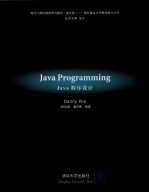图书介绍
Java程序设计=Java Programming:英文PDF|Epub|txt|kindle电子书版本网盘下载

- (新加坡)潘祥春 著
- 出版社: 清华大学出版社
- ISBN:
- 出版时间:2010
- 标注页数:291页
- 文件大小:131MB
- 文件页数:308页
- 主题词:
PDF下载
下载说明
Java程序设计=Java Programming:英文PDF格式电子书版下载
下载的文件为RAR压缩包。需要使用解压软件进行解压得到PDF格式图书。建议使用BT下载工具Free Download Manager进行下载,简称FDM(免费,没有广告,支持多平台)。本站资源全部打包为BT种子。所以需要使用专业的BT下载软件进行下载。如BitComet qBittorrent uTorrent等BT下载工具。迅雷目前由于本站不是热门资源。不推荐使用!后期资源热门了。安装了迅雷也可以迅雷进行下载!
(文件页数 要大于 标注页数,上中下等多册电子书除外)
注意:本站所有压缩包均有解压码: 点击下载压缩包解压工具
图书目录
CHAPTER 1 The Java Programming Environment1.1 History of Java2
1.2 Preparing to Write Java Programs2
1.3 A Simple Java Program3
1.4 How to Run a Java Program?4
1.5 Commonly Encountered Problems5
Workshops5
Workshop 1.1:Preparing the Environment for Java Programming5
Workshop 1.2:How to Run a Java Program?10
Workshop 1.3:How to Compile and Run a Java Program in DOS Prompt?12
Exercises13
CHAPTER 2 The Java Language Components2.1 Print2Numbers Java Program17
2 2 The Java Vocabulary and Character Sets19
2.3 Primitive Data Types19
2.3.1 Boolean20
2.3.2 Characters20
2.3.3 Integers21
2.3.4 Floating Point22
2.3.5 Object References22
2.3.6 String22
2.4 Identifiers22
2.5 Reserved Words23
2.6 Comments24
2.7 Basic Program Structure25
Workshops26
Workshop 2.1:Understanding the Sequence of Program Execution26
Exercises28
CHAPTER 3 Expressions,Statements and Operators3.1 Expression Statements31
3.1.1 Types of Expressions31
3.1.2 Assignment Expression Statements31
3.1.3 Prefix or Postfix Forms of“++”and“--”Statements32
3.1.4 Method Call Statements32
3.1.5 Object Creation Statements32
3.2 Declaration Statements33
3.3 Operators33
3.3.1 Arithmetic Operators34
3.3.2 Auto-Increment and Auto-Decrement Operators35
3.3.3 Logical Operators35
3.3.4 Relational Operators37
3.3.5 Bitwise Operators39
3.3.6 The Conditional Operator“?:”40
3.3.7 Assignment Operators41
3.3.8 “+”Operator43
3.3.9 “.”Operator44
3.3.10 Precedence and Associativity44
Workshops47
Workshop 3.1:Entering Data for Program Execution47
Exercises53
CHAPTER 4 Program Flow Controls56
4.1 Sequence56
4.2 Selection57
4.2.1 Block57
4.2.2 Types of Selection Statements59
4.3 Iteration64
4.3.1 The while Statement64
4.3.2 The do-while Statement66
4.3.3 The for Statement67
4.3.4 The Enhanced'for'Statement70
4.4 Labels70
4 5 The break Statement71
4.6 The continue Statement71
Exercises71
CHAPTER 5 Arravs75
5.1 Array75
5.1.1 Declaring and Creating an Array75
5.1.2 Initializing an Array77
5.1.3 Using Arrays77
5.2 Two-dimensional Arrays79
5.2.1 One-dimensional Array Approach79
5.2.2 Two-dimensional Array Approach80
5.2.3 Populating Two-dimensional Arrays82
5.3 Applying the Enhanced'for'Statement in Arrays83
5.4 An Application:Printing Numbers Divisible by 384
5.4.1 Using Label and break Statement85
5.4.2 Using continue Statement88
Workshops90
Workshop 5.1:Copying Arrays90
Exercises96
CHAPTER 6 Methods98
6.1 Defining a Problem98
6.2 A Problem Solving Approach99
6.3 Improving the Problem-Solving Approach103
6.3.1 Advantage of Using Methods107
6.3.2 Walking Through readInputValues()Method107
6.3.3 Walking Through convertMarksToGrades()Method107
6.3.4 Walking Through printDetails()Method107
6.4 Block Structure and Scope108
6.4.1 Local Variables108
6.4.2 Global Variables109
6.4.3 Determining Scope of Variables across Methods110
6.4.4 Distinguishing Local Variables from Global Variables111
6.4.5 Scope of Identifier Declaration112
6.5 Parameters113
6.5.1 Actual and Formal Parameters113
6.5.2 Value Parameters117
6.6 Methods that Return Values119
6.6.1 Returning Values119
6.6.2 The return Statement121
Workshops121
Workshop 6.1:Using Methods121
Exercises125
CHAPTER 7 Class and Objects128
7.1 Class and Objects128
7.2 Constructing Objects128
7. 2.1 Constructors129
7.2.2 Multiple Constructor Method Definition131
7.2.3 Constructor Method Invocation133
7.3 Instance and Class Variables134
7.4 Instance and Class Methods135
7.4.1 Instance Methods135
7.4.2 Class Methods136
7.5 Constants138
7.6 The this Keyword139
7.6.1 Using this Keyword in Instance Method140
7.6.2 Using this Keyword in Constructor141
7.7 Inner Class141
7.7.1 Compiling an Inner Class142
7.7.2 Static Inner Class143
7.7.3 Creating Inner Class Objects143
7.8 Class Hierarchy143
7.8.1 Superclass and Subclass144
7.8.2 Inheritance146
Workshops148
Workshop 7.1:Implementing Class and Objects148
Exercises153
CHAPTER 8 The Java Application Programming Interface(API)8.1 Java Package157
8.1.1 The'package'Keyword158
8.1.2 The'import'Keyword159
8.1.3 File Name of a Public Class161
8.2 The JavaTM Platform Standard Edition162
8.3 The Java API162
8.3.1 The Java API Documentation163
8.3.2 The Java API Packages164
8.3.3 Directory Structure of Java API Packages167
8.3.4 The java.lang,java.io,and java.util Packages168
8.3.5 Reading the Java API Documentation168
8.3.6 Using the Java API169
8.4 The Ubiquitous System.out.println()Method170
8.4.1 The System Class170
8.4.2 The PrintStream Class171
8.5 String Tokenizers173
8.5.1 The java.util.StringTokenizer Class173
8.5.2 Delimiter Characters175
Exercises176
CHAPTER 9 Inputs and Outputs178
9.1 Input and Output Streams178
9.1.1 Screen Outputs178
9.1.2 Keyboard Inputs179
9.1.3 Reading and Displaying Texts180
9.2 Exception Handling181
9.2.1 Java Exception Handling181
9.2.2 Explicit Exception Handling182
9.3 The Scanner Class185
9.3.1 Creating a Scanner Object186
9.3.2 Handling Numerical Data Types186
9.3.3 Handling String Values186
9.3.4 Handling Boolean Values186
9.3.5 Exceptions and Delimiters187
9.3.6 A Scanner Class Application188
Exercises190
CHAPTER 10 File Handing193
10.1 Text Files193
10.1.1 Writing to a Text File193
10.1.2 Appending Texts to a File195
10.1.3 Reading from a File195
10.2 Binary Files196
Exercises198
CHAPTER 11 Inheritance199
11.1 The Inheritance Mechanism199
11.1.1 Subclass and Superclass199
11.1.2 java.lang.Object Class200
11.1.3 Downward Property Propagation200
11.2 Demonstrating Inheritance200
11.3 The super Keyword202
11.3.1 Syntax202
11.3.2 Constructor Chaining203
11.3.3 Calling Superclass Methods205
11.4 Method Overriding205
Exercises207
CHAPTER 12 Encapsulation216
12.1 Access Modifiers:public,protected,private216
12.1.1 Using Access Modifiers216
12.1.2 Accessibility Effects217
12.2 Data Field Encapsulation218
12.3 Class Abstraction219
12.4 Class Encapsulation220
12.4.1 Encapsulating a Class220
12.4.2 Enhanced Maintainability222
12.4.3 Bundling and Information Hiding225
Exercises226
CHAPTER 13 Polymorphism229
13.1 Illustrating Polymorphism with Geometric Shapes229
13.1.1 The Triangle Class230
13.1.2 The Rectangle Class231
13.1.3 The GeometricShape Class233
13.1.4 The User Class:GeometricShapeMain Class234
13.2 Abstract Class235
13.3 Dynamic Binding236
Exercises237
CHAPTER 14 Interface239
14.1 The Interface Construct239
14.2 Interface Definition239
14.2.1 Interface Declaration and Interface Body240
14.2.2 Compilation of Interface241
14.2.3 Implementing Interface241
14.3 Understanding the Use of Interface243
14.4 What and How in the Use of Interface244
14.5 Application of Interface245
14.5.1 Sales Person Application245
14.5.2 SalesPerson and Employee Class247
14.5.3 Sort by Age:The main()Method 1248
14.5.4 Sort by Name:The main()Method 2250
14.5.5 Sort by Wage:The main()Method 3251
14.5.6 The OutPut251
14.6 The Serializable Interface252
14.7 Interface and Abstract Class257
14.8 Changes in Interface257
14 9 Uses of Interface258
Exercises258
CHAPTER 15 Sorting,Searching,and Recursion15.1 Sorting264
15.1.1 Selection Sort264
15.1.2 Bubble Sort267
15.1.3 A Sorting Application269
15.2 Searching273
15.2.1 Linear Search273
15.2.2 Binary Search274
15.2.3 A Searching Application276
15.3 Recursion280
15.3.1 Recursive Method281
15.3.2 Writing a Recursive Method284
15.3.3 The Ubiquitous Factorial284
15.3.4 Applying Recursion285